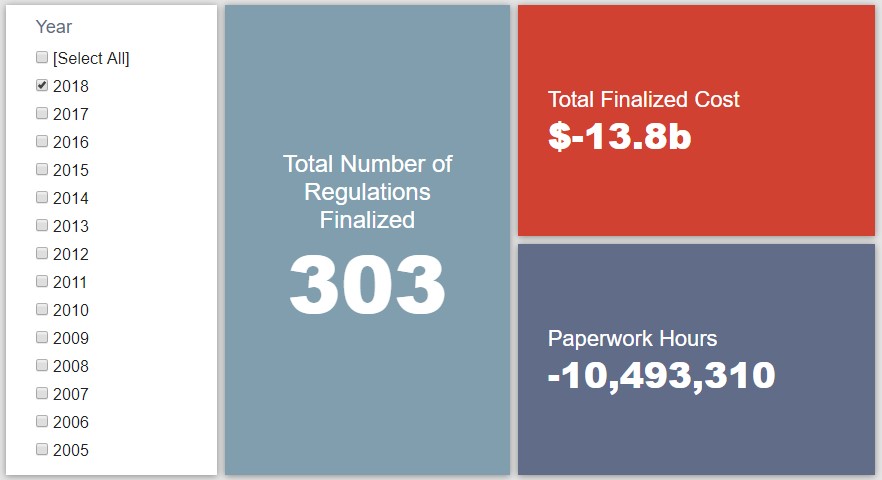Week in Regulation
December 17, 2018
A Billion Dollar Week
All streaks must come to an end. After five consecutive net-deregulatory weeks, agencies increased the cost side of the regulatory ledger last week. The latest round of Renewable Fuel Standards (RFS) and a proposed rule on water quality standards – both out of the Environmental Protection Agency (EPA) – drove the bulk of these new costs. Between both proposed and final rules last week, agencies published $1.1 billion in net costs, but reduced paperwork by 79,464 hours. The per capita regulatory burden for 2018 is negative $42.04.
REGULATORY TOPLINES
- New Proposed Rules: 37
- New Final Rules: 76
- 2018 Total Pages of Regulation: 64,140
- 2018 Final Rules: -$13.8 Billion
- 2018 Proposed Rules: -$545.7 Billion
TRACKING REGULATORY MODERNIZATION
The most expensive rulemaking out of EPA last week was the proposed rule regarding “Establishment of a Numeric Criterion for Selenium for the State of California.” The proposal would “amend the California Toxics Rule to include a revised statewide chronic selenium water quality criterion for California fresh waters to protect aquatic life and aquatic-dependent wildlife.” EPA estimates that this could involve annualized costs of $61 million (at a 7 percent discount rate), or roughly $646 million in present value over a 20-year span. Since it’s still a proposed rule, it does not yet accrue to fiscal year (FY) 2019’s regulatory budget under Executive Order 13,771. The latest edition of RFS, however, does apply to EPA’s current budget. This iteration brings roughly $630 million in new costs, putting EPA in the net-cost column for now.
So far in FY 2019, there have been 19 deregulatory actions against three regulatory actions (per the rubric created by EO 13,771 and the administration’s subsequent guidance document) with quantified net savings of roughly $4.6 billion. The administration’s cumulative savings goal for FY 2019 is approximately $18 billion.
STATE OF MAJOR OBAMA-ERA INITIATIVES
Based on total lifetime costs of the regulations, the Affordable Care Act has imposed costs of $52.9 billion in final state and private-sector burdens and 176.9 million annual paperwork hours.
Since passage, the Dodd-Frank financial reform legislation has produced more than 82.9 million final paperwork burden hours and imposed $38.9 billion in direct compliance costs.
TOTAL BURDENS
Since January 1, the federal government has published $559.5 billion in net cost savings (with $13.8 billion in net savings from final rules) and paperwork burdens amounting to roughly 5.9 million hours (including 10.5 million hours of paperwork reduced under final rules). Click here for the latest Reg Rodeo findings.











